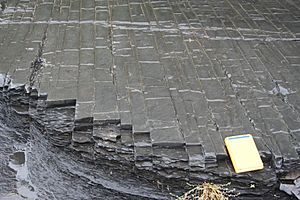Utica Shale facts for kids
Quick facts for kids Utica ShaleStratigraphic range: late Upper Ordovician |
|
|---|---|
| Type | Geological formation |
| Underlies | Lorraine Shale, Martinsburg Formation, and Reedsville Formation |
| Overlies | Trenton Group Canajoharie shale |
| Thickness | up to 1,000 feet (300 m) |
| Lithology | |
| Primary | Shale |
| Location | |
| Coordinates | 43°03′50″N 75°10′48″W / 43.064°N 75.18°W |
| Region | Appalachian Basin |
| Country | |
| Type section | |
| Named for | Utica, New York |
| Named by | Ebenezer Emmons, 1842 |
The Utica Shale is a special layer of rock formed a very long time ago. It was created during the Ordovician Period, which was about 450 million years ago. This rock layer is found deep underground in the Appalachian Basin. It covers a large area across the northeastern United States and parts of Canada.
This rock layer gets its name from Utica, New York. A scientist named Ebenezer Emmons first described it there in 1842. He found it sticking out of the ground near Starch Factory Creek.
Contents
What is Utica Shale Made Of?
The Utica Shale is mostly made of a type of rock called shale. This shale is rich in organic material, which comes from ancient plants and animals. It also contains calcium, which is found in things like seashells.
Oil and Natural Gas in Utica Shale
The Utica Shale is very important because it holds a lot of natural gas and some oil. This gas is called "tight gas" because it's trapped in very small spaces within the rock. Companies use special methods to get it out.
Finding Gas in Quebec
People started drilling for gas in the Utica Shale in Quebec, Canada, in 2006. This activity focused on an area south of the Saint Lawrence River, between Montreal and Quebec City. Companies like Forest Oil Corp. found a lot of gas there.
Forest Oil believed their land in Quebec might hold enough gas to power many homes. Other companies, such as Talisman Energy and Questerre Energy, also drilled wells. They used both straight-down (vertical) and sideways (horizontal) drilling methods.
Even though many wells were drilled, Quebec decided to stop a certain drilling method called hydraulic fracturing in 2012. This method uses water and chemicals to break open the rock and release the gas.
Finding Gas and Oil in Ohio
Drilling in the Utica Shale in Ohio began in 2011. Ohio quickly became a major producer of natural gas and oil from this rock layer. Most of the drilling has happened in eastern Ohio.
The Utica Shale in Ohio is thought to have more oil and other valuable liquids than in other areas. This makes it a very important place for energy production.
Finding Gas in New York
In 2009, a Canadian company called Gastem drilled the first Utica Shale wells in New York. One of these wells was in Otsego County, New York.
However, New York state put a stop to large-scale hydraulic fracturing in 2008. This ban was continued by Governor Andrew Cuomo and is still in place today.
How Much Gas and Oil is There?
Experts have estimated how much gas and oil is in the Utica Shale. In 2012, the US Energy Information Administration thought there were about 15.7 trillion cubic feet of gas that could be recovered. They also estimated that each well could produce a lot of gas.
The United States Geological Survey (USGS) had even higher estimates. They believed the Utica Shale held about 38.2 trillion cubic feet of gas. They also estimated 940 million barrels of oil and 208 million barrels of natural gas liquids. These are huge amounts of energy!
Where is the Utica Shale Found?
The Utica Shale stretches across many states in the United States. These include New York, Pennsylvania, Ohio, and West Virginia. It also extends into parts of Canada, like Ontario and Quebec. You can also find it under Kentucky, Maryland, Tennessee, and Virginia.
In some places, like New York, you can see the Utica Shale on the surface. In other areas, like Quebec and Ontario, it's deep underground.
Parts of the Utica Shale are even under the Island of Montreal. This rock layer is softer than other rocks around it. This softness made building the Montreal metro (subway) very tricky. Some subway stations had to be built in special ways to make sure they were safe. For example, De L'Église station had problems during construction because of the soft rock.
In some parts of Pennsylvania, the Utica Shale is almost two miles deep. But as you go west into Ohio or northwest towards Canada, the rock layer gets closer to the surface.
The Utica Shale can be very thick, up to about 1,000 feet (300 meters). In other places, it can be as thin as 70 feet (21 meters).
How Utica Shale Relates to Other Rocks
The Utica Shale is part of a larger stack of rock layers. It lies above the Trenton Group limestone and the Canajoharie Formation shale. It is found below the Lorraine Group of rocks.
The Utica Shale itself is divided into smaller parts. These are called the Nowadaga Zone, Loyal Creek Zone, and Holland Patent Zone.
It is also located a few thousand feet below another important shale layer called the Marcellus Shale.



